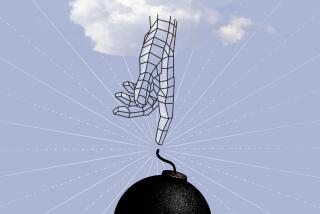THE RECKONING by David Halberstam (Morrow: $19.95; 752 pp.)
- Share via
We are presented these days with an abundance of books about Japanese business, but we are reading them--indeed they are published--because the real subject is not Japan or business, but ourselves. The repeated success of Japanese competition against our major corporations has made us question assumptions about our economy and society, to say nothing of American business.
We ask: What went wrong? Why did we lose?
David Halberstam anticipated our questions. In 1980, the author of “The Best and the Brightest” and “The Powers That Be” saw in the decline of U.S. industry and the rise of Japan a “drama of the highest order and consequence” and the story of the decade. So he set out to pursue it by examining the histories of the Nissan and Ford automobile companies, particularly in the post-World War II period. The result of his five-year labor is “The Reckoning,” and it is a tremendous book.
Halberstam spans the gaps between business and society, between understanding of Japan and knowledge of America. At the beginning of his 752-page book, he cites a business reason for the decline of the U.S. automobile industry--the artificiality and weakness of a competition in which General Motors would raise prices and Ford would follow, unwilling to cut or use pricing to really push its cars because it feared a price war with its powerful adversary. When that oligopoly was exposed to true competition from Japanese companies, it was in the words of one Detroiter like country club tennis players suddenly confronted across the net by Borg and McEnroe.
But Halberstam doesn’t deal in easy villains. He goes immediately beyond business to define the competition as “in sum, between the culture of adversity and the culture of affluence.” Halberstam’s explicit verdict is that we got comfortable and careless. His book’s implicit message is that American society in the postwar period behaved like heirs living off a fortune built up by hard-working forebears.
“The Reckoning” does more than scold, however. One of the book’s strengths is its reporting on Japanese recent history, on how a devastated nation became an economic power.
What spurred Japan? It was the broadening of Japanese society brought about by the reforms of Gen. MacArthur and his occupation administration. The Americans gave Japan a New Deal, very much like our own in the 1930s, broadening the economic horizons and the social participation of a people most of whom previously had felt themselves only the servants of a ruling aristocracy.
It was reform, not revolution, to be sure. Some of Halberstam’s most gripping chapters recount the 1953 crushing of the Nissan union and its talented leader, Tetsuo Masuda. Masuda would have built an industry-wide union modeled on the United Auto Workers. But Japan’s leadership would have none of it. So Nissan management endured a bitter strike and outflanked Masuda by setting up a rival company union. In this, the management was aided by financing from the Industrial Bank of Japan, a government agency, while another arm of the government cautioned Nissan’s competitors not to lure customers away from the struck Nissan.
Clearly, there is more to the Japanese system than stories of harmonious relations between labor and management would have us believe.
But the flaw in the American armor, Halberstam concludes, was not its strong union--he finds the UAW a guilty accomplice in the industry’s downfall. But the blame he fixes on the management of Ford, the original Henry Ford and his grandson, Henry Ford II. The one let his company be run by thugs and incompetents, the latter gave final and excessive authority to the finance department. The men of finance, employing sophisticated systems of accounting, put product development and manufacturing on the defensive, ultimately milking profits from plants starved for investment and cars deficient in quality.
The financial bias unbalanced the business. As what Halberstam calls “the bright young men from the nation’s business schools, careful and cautious and able,” spread through Ford’s executive ranks and the power of finance grew, the cars and the people who made them and even the customers, the people who bought them, seemed to recede in importance. Manufacturing and product quality didn’t return to their proper priority at Ford until the 1980s, after imports had taken more than 25% of the U.S. market. Some of the customers, of course, didn’t return at all.
Why did Henry Ford allow this to happen? Because, suggests Halberstam, his family fortune was concentrated in Ford Motor Co. stock, and in the 1960s, the stock market had changed to a fast game in which investment managers demanded that a company show high current income before they bought shares and kept the price up.
But there is more to it than that. Those same investment managers were employed by Ford and other U.S. companies, after all, to invest company retirement funds. If they demanded high current income, the companies did not resist the demand. A high stock price made executive bonuses affordable and, beyond the bosses, it made high wages affordable, too. When the going was good, a young Detroit assembly line worker could own a home, a cabin by the lake, two cars and a boat.
The finance men gained power because, as trustees of the estate, they were charged with keeping the income flowing to the heirs.
Have we learned our lesson? Is a comeback possible? Maybe, maybe not. Halberstam in his closing chapters recognizes the growing signs that victory has made Japan arrogant. Pride goeth, as they say. And he acknowledges Ford’s renewed attention to quality, which has made it currently the most successful U.S. car company. (Nissan, by contrast, is undergoing difficult times at the moment.)
But his book has already answered the question implicitly. With his gift for going behind the walls of institutions and putting faces and emotions, thoughts and philosophies on faceless bureaucrats, Halberstam shows us that there is infighting, jealousy, spite and stupidity in Japanese corporations, too. But in virtually every individual, there is something more, a consciousness of a larger purpose to their actions--Japan the nation, the Japanese people. Call it vision.
On the American side, there seems little beyond calculated careerism in the contemporary auto industry. One realizes this when Halberstam writes of Semon “Bunkie” Knudsen, who was briefly head of Ford, recalling his father Big Bill Knudsen, the Danish immigrant who became the head of Chevrolet in the 1920s. Big Bill always emphasized to his son that the builders at construction sites weren’t only earning money, they were creating something. And on a trip West, the elder Knudsen showed Bunkie the Golden Gate Bridge. “There was nothing here before they did this,” said the father, “What these men did will be here forever, and it will make people’s lives better.”
When American business gets back to thinking of itself as making people’s lives better, it need not fear the reckoning.
More to Read
Sign up for our Book Club newsletter
Get the latest news, events and more from the Los Angeles Times Book Club, and help us get L.A. reading and talking.
You may occasionally receive promotional content from the Los Angeles Times.








